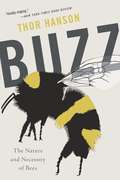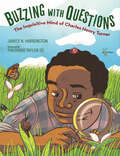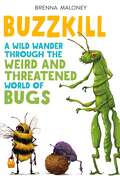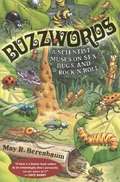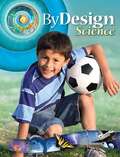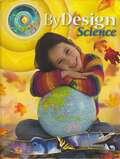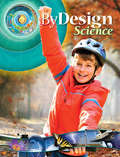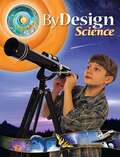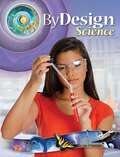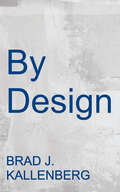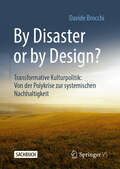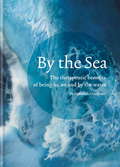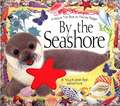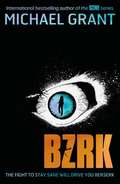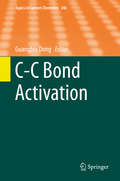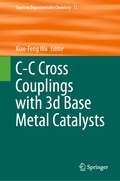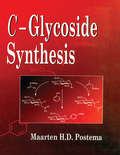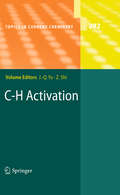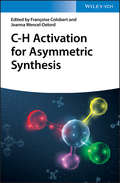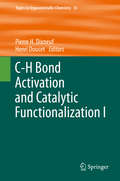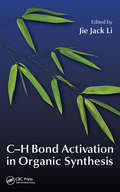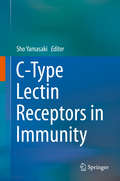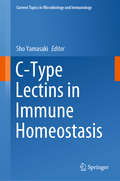- Table View
- List View
Buzz: The Nature and Necessity of Bees
by Thor HansonFrom the award-winning author of The Triumph of Seeds and Feathers, a natural and cultural history of the buzzing wee beasties that make the world go round.Bees are like oxygen: ubiquitous, essential, and, for the most part, unseen. While we might overlook them, they lie at the heart of relationships that bind the human and natural worlds. In Buzz, the beloved Thor Hanson takes us on a journey that begins 125 million years ago, when a wasp first dared to feed pollen to its young. From honeybees and bumbles to lesser-known diggers, miners, leafcutters, and masons, bees have long been central to our harvests, our mythologies, and our very existence. They've given us sweetness and light, the beauty of flowers, and as much as a third of the foodstuffs we eat. And, alarmingly, they are at risk of disappearing.As informative and enchanting as the waggle dance of a honeybee, Buzz shows us why all bees are wonders to celebrate and protect. Read this book and you'll never overlook them again.
Buzzing with Questions: The Inquisitive Mind of Charles Henry Turner
by Janice N. HarringtonThe story of Charles Henry Turner, the first Black entomologist — a scientist who studies bugs — is told in this fascinating book for young readers.Can spiders learn? How do ants find their way home? Can bugs see color? All of these questions buzzed endlessly in Charles Henry Turner&’s mind. He was fascinated by plants and animals and bugs. And even when he faced racial prejudice, Turner did not stop wondering. He constantly read, researched, and experimented. Author Janice Harrington and artist Theodore Taylor III capture the life of this inspiring scientist and educator in this nonfiction picture book, highlighting Turner's unstoppable quest for knowledge and his passion for science. The extensive back matter includes an author's note, time line, bibliography, source notes, and archival images.A NSTA/CBC Best STEM Book
Buzzkill: A Wild Wander Through the Weird and Threatened World of Bugs
by Brenna MaloneyThe praying mantis is the only animal on Earth with one ear—and it’s in the middle of its chest. Aphids are born pregnant. Moths can’t fly during an earthquake. If you didn’t know these things, you soon will. Packed full of jaw-dropping facts, Buzzkill presents the big picture on bugs. You might think ew, gross. Insects are icky. Or scary. Or dangerous. They can be. But there’s so much more you need to know.Insects play a critical role on our planet, from sustenance to pollination to medicines and more. Brenna Maloney tackles both the wacky and weird, as well as threats to insects and their habitats, their possible extinction, and ways that everyday people, like you, can prevent their decline.Find out what all the buzz is about!Godwin BooksA JUNIOR LIBRARY GUILD GOLD STANDARD TITLE
Buzzwords: A Scientist Muses On Sex, Bugs, And Rock 'n' Roll
by May R. BerenbaumWhat sort of person devotes their life to the study of bugs? How do you picture your average, every-day entomologist? "I've been photographed on several occasions," writes author May Berenbaum, "and it seems that every time, photographers ask me to pose in one of three ways: seated in front of a microscope, with an insect (usually a cockroach) on my face, or with an insect net clutched in my hand."In Buzzwords, Berenbaum expertly blows away these stereotypes with short takes on all things entomological--from the story of a pet ant kept for 14 years to major motion pictures featuring cockroaches.Buzzwords showcases the Best of Berenbaum, a selection from her humor column in the American Entomologist professional journal, accompanied by a number of original pieces written for this book. "I know people are reading these columns," she notes, "because they write me letters that point out all the mistakes I've made!"The book comes in four parts: How entomologists see insects, including their view of a U.S. government plan to eradicate illicit coca fields by dropping caterpillars from airplanes.How the rest of the world sees insects, with Berenbaum's proposed classificatory scheme for placing Spider Man, Firefly, and other cartoon superheroes into well-defined taxa.How entomologists view themselves--featuring Bambi Berenbaum, a gorgeous entomologist created for an episode of TV's popular "The X-Files," whose character was inspired when the scriptwriter consulted Berenbaum's books.How entomologists see their colleagues, with various views on scholarly citation, motion sickness, and more. Along the way are some thought-provoking observations--for example, about the impact of television on public knowledge of science. In one poll, Berenbaum writes, 35% of adults said they believed that prehistoric humans coexisted with dinosaurs, a la the Flintstones.Berenbaum even takes on the controversy over alternative medicine, fearlessly purchasing Chinese medicinal insects during a professional trip to Vancouver, which also happened to be her honeymoon. "Okay, so maybe giving two talks at an International Congress of Entomology is not everybody's idea of a romantic honeymoon venue, but it seemed like a good idea at the time."Berenbaum is a noted scientist in a field that doesn't always gets the respect it deserves, but she shows us that there's a fun and even freaky side of life with insects. While working on the University of Illinois' annual Insect Fear Film Festival she received a letter from a "crush freak" who waxed lyrical about a young, sexy babe with a size 9 or 10 shoe. Berenbaum writes, "On the one hand, it's almost gratifying to think that insect pest management can arouse people's interest to such an extreme extent. On the other hand, it has convinced me not to list my shoe size in the biographical sketch of my next book."Readers will appreciate learning how the word "shloop" was introduced to the medical literature when physicians used a metal suction tip to remove a cockroach from a patient's ear canal, and how one investigator named a series of subspecies bobana, cocana, dodana, and so forth, "anticipating by 60 years the song, 'The Name Game,' by Shirley Ellis."Although you'll chuckle all the way, Berenbaum has the last laugh, giving powerful lessons in the spectacular diversity of the insect world and the nature of scientific discovery, cleverly packaged as witty observations on subjects far and wide.If you're a scientist or you like reading about science--better yet, if you've ever found a fly in your soup (or worried that you might have unknowingly just slurped one down with your tomato bisque--this book is for you.
By Design Grade 2 Student Edition
by BY DESIGN ROYALTY ESCROW ACCOUNTBy Design Grade 2 Student Edition
By Design Grade 3 Student Edition
by BY DESIGN ROYALTY ESCROW ACCOUNTBy Design Grade 3 Student Edition
By Design Grade 7 Student Edition
by BY DESIGN ROYALTY ESCROW ACCOUNTBy Design Grade 7 Student Edition
By Design Science: Grade 8 Student Edition
by BY DESIGN ROYALTY ESCROW ACCOUNTBy Design Grade 8 Student Edition
By Design: Ethics, Theology, and the Practice of Engineering
by Brad J. KallenbergBoth engineering and human living take place in a messy world, one chock full of unknowns and contingencies. "Design reasoning" is the way engineers cope with real-world contingency. Because of the messiness, books about engineering design cannot have "ideal solutions" printed in the back in the same way that mathematics textbooks can. Design reasoning does not produce a single, ideally correct answer to a given problem but rather generates a wide variety of rival solutions that vie against each other for their relative level of "satisfactoriness," a reasoning process analogous to design is needed in ethics. <p><p>Since the realm of interpersonal relations is itself a fluid and highly contingent real-world affair, design reasoning offers the promise of a useful paradigm for ethical reasoning. This volume undertakes two tasks. First, it employs design reasoning to illustrate how technological artifacts can be assessed for their inherent moral properties. Second, it uses the design paradigm as a means for bringing engineering ethics into conversation with Christian theology in order to show how each can be for the other a catalyst for the revolutionary task of living by design.
By Disaster or by Design?: Transformative Kulturpolitik: Von der Polykrise zur systemischen Nachhaltigkeit
by Davide BrocchiJede große Transformation in der Geschichte der Menschheit wurde bisher von einer kulturellen Revolution ausgelöst und begleitet. Diese Publikation zeigt, warum dies auch für die Transformation zur Nachhaltigkeit gilt. Im Fokus stehen nicht nur Werte, Menschen- und Naturbilder, sondern auch die gesellschaftliche Verantwortung von Bildung, Wissenschaft, Kunst und Medien. Für die zweite Auflage wurden die Inhalte überarbeitet und aktualisiert, Thesen geschärft und neue Studien einbezogen.Gegenwärtig befinden wir uns zwischen zwei großen gesellschaftlichen Transformationen: Die erste ist die kapitalistisch-industrielle, die vor fünf Jahrhunderten begann, bis heute dominiert und sich am Kulturprogramm der Modernisierung orientiert. Sie hat die Gesellschaft in eine Polykrise geführt, es droht ein Zivilisationskollaps. Die zweite Transformation ist jene zur Nachhaltigkeit, die sich an „Visionen einer anderen Entwicklung“ jenseits von Wachstum und Massenkonsum orientiert. Diese beiden Transformationen verdrängen sich an einigen Stellen gegenseitig und vermischen sich an anderen. Einerseits ist es die schwächere Transformation, die oft assimiliert wird. So werden derzeit eine „ökologische Modernisierung“ und ein „nachhaltiges Wachstum“ theorisiert, obwohl solche Ansätze Widersprüche an sich sind. Andererseits ist die soziale und ökologische Umwelt ein politisches Subjekt, das immer stärker in Dynamiken und Debatten mitmischt. So oder so wird sich an den Reibungsflächen zwischen den beiden Transformationen entscheiden, wie sich die Transformation zur Nachhaltigkeit am Ende durchsetzt: by Disaster or by Design.
By the Sea: The therapeutic benefits of being in, on and by the water
by Dr Deborah CracknellIn this stunning book, intuition and instinct meet modern science as the therapeutic benefits of being in, on or by the sea are explained and explored, and how, if we look after the oceans they will, in turn, look after us. There is something about the vastness of the oceans, which are significantly larger than the continents combined, that has drawn humans in a significant way since the beginning of coastal communities. Throughout history, people have gravitated to live near the sea, it is part of the survival instinct. Water also has huge cultural and spiritual significance for people through the ages and for centuries we looked to the sand and surf as a fully-stocked medicine cabinet. Despite the widespread intuitive feeling that being by the water makes us happier and healthier, there hasn't been much scientific evidence to quantify this connection. Until now. Environmental psychology is the study of how the natural environment makes us feel, think and behave, and scientists in this area are discovering the tangible benefits of breathing in the fresh sea air.Reasons to spend time by the sea:1. Just looking at the sea can promote reductions in heart rate and improvements in mood.2. The negative ions in sea air accelerate your ability to absorb oxygen, and balance your seratonin levels.3. The bracing climate is especially beneficial to the respiratory organs and the skin, and also improves circulation and strengthens the body's defences.4. Spending time by the sea promotes better mental health.5. When you are by the sea you are more likely to exercise.
By the Sea: The therapeutic benefits of being in, on and by the water
by Dr Deborah CracknellIn this stunning book, intuition and instinct meet modern science as the therapeutic benefits of being in, on or by the sea are explained and explored, and how, if we look after the oceans they will, in turn, look after us. There is something about the vastness of the oceans, which are significantly larger than the continents combined, that has drawn humans in a significant way since the beginning of coastal communities. Throughout history, people have gravitated to live near the sea, it is part of the survival instinct. Water also has huge cultural and spiritual significance for people through the ages and for centuries we looked to the sand and surf as a fully-stocked medicine cabinet. Despite the widespread intuitive feeling that being by the water makes us happier and healthier, there hasn't been much scientific evidence to quantify this connection. Until now. Environmental psychology is the study of how the natural environment makes us feel, think and behave, and scientists in this area are discovering the tangible benefits of breathing in the fresh sea air.Reasons to spend time by the sea:1. Just looking at the sea can promote reductions in heart rate and improvements in mood.2. The negative ions in sea air accelerate your ability to absorb oxygen, and balance your seratonin levels.3. The bracing climate is especially beneficial to the respiratory organs and the skin, and also improves circulation and strengthens the body's defences.4. Spending time by the sea promotes better mental health.5. When you are by the sea you are more likely to exercise.
By the Seashore
by Maurice Pledger A. J. Wood Becki WardMany things to see and feel-- Crusty coral, a furry seal, Seashells of all shapes and sizes-- An ocean full of nice surprises. Combining wonderful illustrations with lift-a-flaps and touch-and-feel components, this unique book introduces children to the different textures that they might find on the seashore.
Bzrk
by Michael GrantThe most breathtaking and exhilarating ride you will take this year, this is the first in an incredible new action thriller series from Michael Grant, author of Gone. These are no ordinary soldiers. This is no ordinary war. Welcome to the nano, where the only battle is for sanity. Losing is not an option when a world of madness is at stake. Time is running out for the good guys. But what happens when you don¿t know who the good guys really are? Noah and Sadie: newly initiated to an underground cell so covert that they don¿t even know each other¿s names. Here they will learn what it means to fight on a nano level. Soon they will become the deadliest warriors the world has ever seen. Vincent: feels nothing, cares for no one; fighting his own personal battle with Bug Man, the greatest nano warrior alive. The Armstrong Twins: wealthy, privileged, fanatical. Are they the saviours of mankind or authors of the darkest conspiracy the world has ever seen?The nano is uncharted territory. A terrifying world of discovery. And everything is to play for . . .
C-C Bond Activation (Topics in Current Chemistry #346)
by Guangbin DongThe series Topics in Current Chemistry presents critical reviews of the present and future trends in modern chemical research. The scope of coverage is all areas of chemical science including the interfaces with related disciplines such as biology, medicine and materials science. The goal of each thematic volume is to give the non-specialist reader, whether in academia or industry, a comprehensive insight into an area where new research is emerging which is of interest to a larger scientific audience. Each review within the volume critically surveys one aspect of that topic and places it within the context of the volume as a whole. The most significant developments of the last 5 to 10 years are presented using selected examples to illustrate the principles discussed. The coverage is not intended to be an exhaustive summary of the field or include large quantities of data, but should rather be conceptual, concentrating on the methodological thinking that will allow the non-specialist reader to understand the information presented. Contributions also offer an outlook on potential future developments in the field. Review articles for the individual volumes are invited by the volume editors. Readership: research chemists at universities or in industry, graduate students
C-C Cross Couplings with 3d Base Metal Catalysts (Topics in Organometallic Chemistry #93)
by Xiao-Feng WuThis volume presents recent progress on 3d base metal catalyzed C-C cross coupling reactions. The contributions provide detailed discussions on the use of cheap metal catalysts such as Cr, Mn, Fe, Co, Ni, Cu, and Zn to construct Csp2-Csp2, Csp2-Csp3 and Csp3-Csp3 bonds with a variety of substrates. These non-noble metal catalyst have many advantages such as being inexpensive, having low toxicity and are environmentally benign. Therefore the use of cheap metal catalysts in organic synthesis has gained much attention in efforts to develop more sustainable synthetic green chemistry. Each chapter is written by international experts in the field and is a great resource for students, researchers and chemists working in industry to gain an overview on the latest developments.
C-Glycoside Synthesis (New Directions In Organic And Biological Chemistry Ser.)
by Maarten PostemaThis book examines methods particularly well suited for either a- or b-C-glycoside formation. It helps field workers quickly select the best method for synthesizing a particular type of C-glycoside. The use of C-glycosides as synthons in natural product synthesis is also addressed.
C-H Activation (Topics in Current Chemistry #292)
by Jin-Quan Yu Zhangjie ShiTable of Contents - Synthesis in the Key of Catellani: Norbornene-Mediated ortho C-H Functionalization - Mechanistic Considerations in the Development and Use of Azine, Diazine and Azole N-Oxides in Palladium-Catalyzed Direct Arylation - Palladium and Copper Catalysis in Regioselective, Intermolecular Coupling of C-H and C-Hal Bonds - Pd-Catalyzed C-H Bond Functionalization on the Indole and Pyrrole Nucleus - Remote C-H Activation via Through-Space Palladium and Rhodium Migrations - Palladium-Catalyzed Aryl-Aryl Bond Formation Through Double C-H Activation - Palladium-Catalyzed Allylic C-H Bond Functionalization of Olefins - Ruthenium-Catalyzed Direct Arylations Through C-H Bond Cleavages - Rhodium-Catalyzed C-H Bond Arylationof Arenes - Cross-Dehydrogenative Coupling Reactions of sp3-Hybridized C-H Bonds - Functionalization of Carbon-Hydrogen Bonds Through Transition Metal Carbenoid Insertion - Metal-Catalyzed Oxidations of C-H to C-N Bonds
C-H Activation for Asymmetric Synthesis
by Françoise ColobertProvides, in one handbook, comprehensive coverage of one of the hottest topics in stereoselective chemistry Written by leading international authors in the field, this book introduces readers to C-H activation in asymmetric synthesis along with all of its facets. It presents stereoselective C-H functionalization with a broad coverage, from outer-sphere to inner-sphere C-H bond activation, and from the control of olefin geometry to the induction of point, planar and axial chirality. Moreover, methods wherein asymmetry is introduced either during the C-H activation or in a different elementary step are discussed. Presented in two parts?asymmetric activation of C(sp3)-H bonds and stereoselective synthesis implying activation of C(sp2)-H bonds?CH-Activation for Asymmetric Synthesis showcases the diversity of stereogenic elements, which can now be constructed by C-H activation methods. Chapters in Part 1 cover: C(sp3)-H bond insertion by metal carbenoids and nitrenoids; stereoselective C-C bond and C-N bond forming reactions through C(sp3)?H bond insertion of metal nitrenoids; enantioselective intra- and intermolecular couplings; and more. Part 2 looks at: C-H activation involved in stereodiscriminant step; planar chirality; diastereoselective formation of alkenes through C(sp2)?H bond activation; amongst other methods. -Covers one of the most rapidly developing fields in organic synthesis and catalysis -Clearly structured in two parts (activation of sp3- and activation of sp2-H bonds) -Edited by two leading experts in C-H activation in asymmetric synthesis CH-Activation for Asymmetric Synthesis will be of high interest to chemists in academia, as well as those in the pharmaceutical and agrochemical industry.
C-H Bond Activation and Catalytic Functionalization II (Topics in Organometallic Chemistry #55)
by Pierre H. Dixneuf Henri DoucetThe series Topics in Organometallic Chemistry presents critical overviews of research results in organometallic chemistry. As our understanding of organometallic structure, properties and mechanisms increases, new ways are opened for the design of organometallic compounds and reactions tailored to the needs of such diverse areas as organic synthesis, medical research, biology and materials science. Thus the scope of coverage includes a broad range of topics of pure and applied organometallic chemistry, where new breakthroughs are being achieved that are of significance to a larger scientific audience. The individual volumes of Topics in Organometallic Chemistry are thematic. Review articles are generally invited by the volume editors. All chapters from Topics in Organometallic Chemistry are published OnlineFirst with an individual DOI. In references, Topics in Organometallic Chemistry is abbreviated as Top Organomet Chem and cited as a journal.
C-H Bond Activation in Organic Synthesis
by Jie Jack LiGreener than conventional methods, C-H activation methods have flourished during the last decade and become especially attractive to organic chemists. Edited by a practioner in this rapidly developing field, C-H Bond Activation in Organic Synthesis provides an overview of this exciting playground of chemistry. The book summarizes the state of the a
C-Type Lectin Receptors in Immunity
by Sho YamasakiThe book presents the latest findingson C-type lectin receptors, focusing on individual receptors and theirsignaling. In recent years there have been great advances in the understandingof the function of these receptors as a newly emerging family of pattern-recognitionreceptors (PRRs) for pathogen-associated molecular patterns (PAMPs) anddamage-associated molecular patterns (DAMPs). Comprising four parts:ITAM-coupled Activating Receptors; HemITAM-bearing Receptors; ITIM-bearingReceptors; and Other Receptors and Related Topics, this comprehensive reviewcovers a broad range of C-type lectin receptors. The updated information onC-type lectin receptors and their ligands provided will appeal to a widereadership, from basic immunologists to physicians and surgeons. In addition,sections on novel drug development make this a valuable resource forpharmaceutical scientists.
C-Type Lectins in Immune Homeostasis (Current Topics in Microbiology and Immunology #429)
by Sho YamasakiThis book focuses on C-type lectin receptors, a newly emerging family of pattern-recognition receptors (PRRs) and a crucial part of the human innate immune system. Above all, the authors highlight these receptors’ role in the recognition of pathogen-associated molecular patterns (PAMPs) and damage-associated molecular patterns (DAMPs) – one of the first steps in responding to foreign and potentially dangerous structures in the human body. The respective chapters chiefly examine various C-type lectin receptors, their corresponding ligands, and signalling. In addition to offering immunologists and clinicians important insights from the latest research, they may also provide novel points of departure for future drug development.
